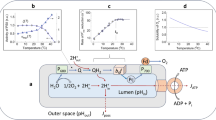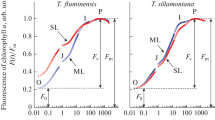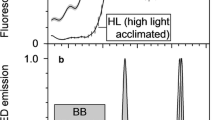Abstract
The electron transport rates of photosystems II and I, amounts of electron carriers, coupling factor activity and photosynthetic rates were investigated in thylakoids isolated from pea plants grown under a wide range of light intensities (16 h light-8 h dark). The electron transport rates of PS II and PS I, as partial reactions or in whole chain, and coupling factor activity on a unit chlorophyll basis, all increased as the light intensity available for growth was altered from a very low intensity of 10 μE m-2s-1 to a high intensity of 840 μE m-2s-1. Similarly, there were increases in the amounts of atrazine binding sites, plastoquinine, cytochrome f and P700 per unit chlorophyll; significantly, the amounts of reaction centres of PS II and PS I were not equal at any light intensity. The rate of change of all parameters with respect to light intensity could be represented by two straight lines of different slopes which met at a transition point corresponding to approximately 200 μE m-2s-1 during growth. These photoadaptations were similar to those observed for both the relative distribution of chlorophyll in chlorophyll-protein complexes and the chl a/chl b ratios [Leong and Anderson, 1984, Photosynthesis Research 5:117–128]. Since these thylakoid components and functions were affected in the same direction by light intensity during growth and all show linear relationships with chl a/chl b ratios, it indicates that they are closely regulated and markedly well co-ordinated. Plants compensate for the limited amount of low light intensities by drastically increasing the light-harvesting antenna unit size of photosystem II and to a lesser extent that of photosystem I. Changes in the composition of the thylakoid membranes exert a regulatory effect on the overall photosynthetic rate up to approximately 450 μE m-2s-1.
Similar content being viewed by others
Abbreviations
- chl:
-
chlorophyll
- cyt:
-
cytochrome
- PQ:
-
plastoquinone
- PS:
-
photosystem
References
Åkerlund H-E, Andersson B and Albertsson P-Å (1976) Isolation of photosystem II-enriched membrane vesicles from spinach chloroplasts by phase partition. Biochim Biophys Acta 449: 525–535
Ames BN (1966) Assay of inorganic phosphate, total phosphate and phosphatases. Methods Enzymol 8: 115–118
Anderson JM (1982) The role of chlorophyll-protein complexes in the function and structure of chloroplast thylakoids. Mol Cell Biochem 46: 161–172
Anderson JM and Andersson B (1982) The architecture of photosynthetic membranes: lateral and transverse organization. Trends Biochem Sciences 7: 288–292
Barr R and Crane FL (1971) Quinones in algae and higher plants. Methods Enzymol. 23: 372–408
Bendall DS, Davenport HE and Hill R (1971) Cytochrome components in chloroplansts of the higher plants. Methods Enzymol 23: 327–344
Berzborn RJ, Müller D, Ross P and Andersson B (1981) Significance of different quantitative determinations of photosynthetic ATP-synthase CF1 for heterogeneous CFI distribution and grana formation. In Akovunoglou G ed. Photosynthesis III. Structure and molecular organization of the photosynthetic apparatus, pp 107–120. Philadelphia, Pa: Balaban International Science Services
Björkman O (1981) Responses to different quantum flux densities. In Lange OK, Nobel PS, Osmond CB and Ziegler H eds. Encyclopaedia of Plant Physiology Vol 12A: Physiological Plant Ecology, pp 57–107. Berlin: Springer-Verlag
Boardman NK (1977) Comparative photosynthesis of sun and shade plants. Annu Rev Plant Physiol 28: 355–377
Boardman NK, Björkman O, Anderson JM, Goodchild DJ and Thorne SW (1974) Photosynthetic adaptation of higher plants to light intensity: Relationship between chloroplast structure, composition of the photosystems and photosynthetic rates. In Avron M ed. Proc 3rd Int Congr on Photosynthesis pp 1809–1827. Amsterdam: Elsevier
Hurt E and Hauska G (1981) A cytochrome f/b6 complex of five polypeptides with plastoquinol-plastocyanin-oxido-reductase activity from spinach chloroplasts. Eur J Biochem 117: 591–599
Leong T-Y and Anderson JM (1983) Changes in composition and function of thylakoid membranes as a result of photosynthetic adaptation of chloroplasts from pea plants grown under different light conditions. Biochim Biophys Acta 723: 391–399
Leong T-Y and Anderson JM Adaption of the thylakoid membranes of pea chloroplasts to various light intensities. I. Study on the distribution of chlorophyll-protein complexes. In this issue
Leong T-Y and Anderson JM (1983) Effect of temperature during growth on the distribution of chlorophyll-protein complexes, coupling factor CF1 activity and photosynthetic rates in two cultivars of sunflower. Proceedings of VIth Int Photosynthesis Cong: In press
Markwell JP, Thornber JP, Skrdla MP (1980) Effect of detergents on the reliability of a chemical assay for P-700. Biochim Biophys Acta 591: 391–399
Melis A and Brown JS (1980) The stoichiometry of System I and II reaction centres in different photosynthetic membranes. Proc Nat Acad Sci 77: 4712–4716
Melis A and Harvey GW (1981) Regulation of photosystem stoichiometry, chlorophyll a and chlorophyll b content and relation to chloroplast ultrastructure. Biochim Biophys Acta 637: 138–145
Pfister K, Steinback KE, Gardner G and Arntzen CJ (1981) Photoaffinity labelling of an hebicide receptor protein in chloroplast membranes. Proc Natl Acad Sci 78: 981–985
Pick U and Bassilian S (1981) Octyl glucoside stimulates a Mg++-specific ATPase activity in chloroplast CF1. In Selman BR Selman-Reimer S eds. Energy Coupling in Photosynthesis, pp 251–260. Amsterdam: Elsevier
Satoh K, Nakatani HY, Steinback KE, Watson J and Arntzen CJ (1983) Polypeptide composition of a photosystem II core complex. Presence of a herbicide-binding protein. Biochim Biophys Acta 724: 142–150
Senger H and Fleischhacker PH (1978) Adaption of the photosynthetic apparatus of Scenedesmus obliquus to strong and weak light conditions. I. Differences in pigments, photosynthetic capacity, quantum yield and dark reactions. Physiol Plant 43: 35–42
Tischer W and Strotmann H (1977) Relationship between inhibitor binding by chloroplasts and inhibition of photosynthetic electron transport. Biochim Biophys Acta 460: 113–125
Wild A (1979) Physiology of photosynthesis in higher plants. The adaptation of photosynthesis to light intensity and light quality in higher plants. Ber Deutsch Bot Ges 92: 341–364
Wong SC, Cowan IR and Farquar GD (1979) Stomatal conductance correlates with photosynthetic capacity. Nature 282: 424–426
Author information
Authors and Affiliations
Rights and permissions
About this article
Cite this article
Leong, TY., Anderson, J.M. Adaptation of the thylakoid membranes of pea chloroplasts to light intensities. II. Regulation of electron transport capacities, electron carriers, coupling factor (CF1) activity and rates of photosynthesis. Photosynth Res 5, 117–128 (1984). https://doi.org/10.1007/BF00028525
Received:
Revised:
Issue Date:
DOI: https://doi.org/10.1007/BF00028525




